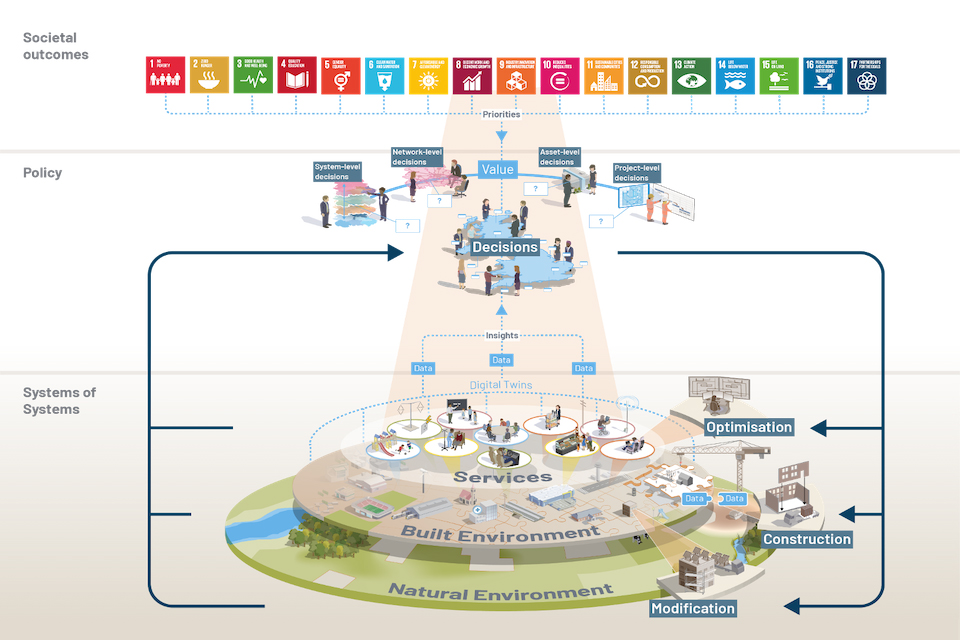There is much to digest in the Transforming Infrastructure Performance Roadmap to 2030 (TIP Roadmap). Here, Dan Rossiter highlights the points that resonate the most with him.
The eagerly awaited TIP Roadmap by the Infrastructure & Projects Authority (IPA) discusses its five focus areas, cites key case studies, and provides an action plan to realise their vision for 2030.
Perhaps most interesting for the readers of BIM+ is Focus Area 5: Optimising the performance of our existing built environment, which makes several references to the UK BIM Framework, as well as providing a refreshed government mandate for BIM – the Information Management Mandate. John Ford has already talked about Why we need the new BIM mandate, so I thought I’d pull out some interesting parts of the TIP Roadmap that resonated with me and the future of the built environment.
The transformation trio
The TIP Roadmap succeeds the Government Construction Strategy and has been developed to sit alongside the Construction Playbook and the National Infrastructure Strategy. For the next decade, it is these three documents that will influence the direction of change within the built environment. The TIP Roadmap builds upon the launch of the TIP in 2017 by looking to meet contemporary challenges such as digitalisation, regeneration, and achieving net zero carbon.
The Built Environment Model
To that end, the IPA has developed a Built Environment Model (image below) that looks to draw a direct line to the UN Sustainable Development Goals and a new approach to decision-making based on the interlinked nature of the built environment, natural environment, and the services they provide.

What I find most interesting is the incorporation of thinking described within the Centre for Digital Built Britain publication Flourishing Systems as well as the use of ‘Built Environment’ to cover both construction and infrastructure.
Reunification of infrastructure and construction
Elsewhere in the document, it includes the following statement: “It will end what is seen as an artificial separation between infrastructure and construction.” This single statement is as transformational as it is philosophical. In fact, with Focus Area 4 relating to the retrofit of buildings, this document appears to further reinforce the concept that buildings such as schools, hospitals, and housing are considered social infrastructure while infrastructure relating to telecommunication, energy, waste, water and transport are considered economic infrastructure.

“Any move to dissolve silos within the built environment, as well as to reinforce the need to consider a collective purpose and outcomes, can only be seen as a positive move.”
Outcomes and data-driven decision-making
Any move to dissolve silos within the built environment, as well as to reinforce the need to consider a collective purpose and outcomes, can only be seen as a positive move.
Throughout, the TIP Roadmap reinforces two principal concepts: the need to consider outcomes as opposed to outputs; and the decisions relating to those outcomes should be driven by insights derived from (structured) Information. To receive valid information to produce these insights, careful consideration is needed as to what information is required and when. As such, it is no surprise that the UK BIM Framework plays such a pivotal role.
In addition, it is great to see references to interoperability and the desire for effective, secure, and resilient cross-organisational exchanges of information, which the Information Management Framework and the National Digital Twin programme are working hard to realise.
Standardisation
Finally, to no one’s surprise, I am overjoyed at the importance that standards are given within the TIP Roadmap. Not only does it cite BSI’s leadership around retrofit, but also makes several references for the need to adopt technical standards as well as the opportunity to leverage scale and efficiency through standardisation.
The TIP Roadmap, for example, cites the need for government to name spaces more consistently. Technical standards such as BS EN ISO 4157-2 (Construction drawings. Designation systems – Room names and Numbers) support this exact need. With the Information Management Mandate requiring conformance to the standards that constitute the UK BIM Framework, and the desire to introduce future mandates around platforms and digital twins, we, as the UK’s national standards body, look forward to supporting IPA in realising their action plan.
In summary, I’m really excited by the concepts that have either been introduced or enforced by the TIP Roadmap and, like many of you, will be working hard to help make IPA’s vision for 2030 a reality.
Dan Rossiter is sector lead (digital transformation) at BSI














